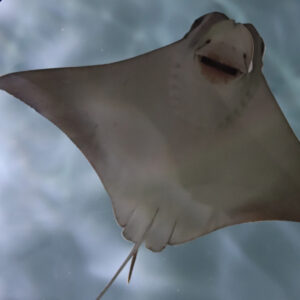Cownose Ray

Surf Through Summer Like a Cownose Ray
This month we are celebrating our Cownose Ray, Suzy, who is about 5 years old. She is Discovery World’s only Cownose Ray, and she can be found swimming above your head in the tunnel of our 65,000-gallon saltwater Caribbean tank. Suzy is about half the size she will grow to be. Generally, cownose rays grow to be 3 feet across, from wingtip to wingtip. She’s still young, as they normally live to be about 15-20 years old. Eventually, Discovery World will get more cownose rays to join Suzy in her tank. If we get a male cownose ray, Suzy could grow up to be a mother.
Cownose rays are ovoviviparous. This means that their eggs develop and hatch inside their bodies. The embryo first lives off the yolk sac inside the egg, and once the embryo hatches, it receives its nutrients from the uterus of the mother. When the baby is finally able to survive on its own, the mother gives birth. Normally, there’s only one pup at a time, so most likely, Suzy didn’t have any siblings when she was born.
You’ll most likely see Suzy constantly swimming in our Caribbean tank. That’s because cownose rays are very strong swimmers and have long migrations every year. They form large schools of rays and migrate over 930 miles of the Western Atlantic coastline. They travel from Florida to the Southern Caribbean every year! There have been schools of cownose rays as large as 10,000 rays!
Threats
Cownose rays are considered to be “near threatened” with extinction. They swim near the surface and are often accidentally captured as “bycatch” in fishing nets. Make sure to visit Suzy in our Caribbean Tunnel Tank this month.
Explore More…
Discover and learn about our Suzy our Cownose in our Caribbean Tunnel Tank. Catch divers in the tank weekly. Explore our calendar for more details: Calendar of Events.
